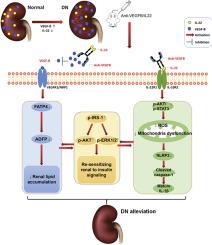Acta Pharmaceutica Sinica B ( IF 14.5 ) Pub Date : 2020-07-13 , DOI: 10.1016/j.apsb.2020.07.002 Yilan Shen , Wei Chen , Lei Han , Qi Bian , Jiajun Fan , Zhonglian Cao , Xin Jin , Tao Ding , Zongshu Xian , Zhiyong Guo , Wei Zhang , Dianwen Ju , Xiaobin Mei

|
Diabetic nephropathy (DN) is considered the primary causes of end-stage renal disease (ESRD) and is related to abnormal glycolipid metabolism, hemodynamic abnormalities, oxidative stress and chronic inflammation. Antagonism of vascular endothelial growth factor B (VEGF-B) could efficiently ameliorate DN by reducing renal lipotoxicity. However, this pharmacological strategy is far from satisfactory, as it ignores numerous pathogenic factors, including anomalous reactive oxygen species (ROS) generation and inflammatory responses. We found that the upregulation of VEGF-B and downregulation of interleukin-22 (IL-22) among DN patients were significantly associated with the progression of DN. Thus, we hypothesized that a combination of a VEGF-B antibody and IL-22 could protect against DN not only by regulating glycolipid metabolism but also by reducing the accumulation of inflammation and ROS. To meet these challenges, a novel anti-VEGFB/IL22 fusion protein was developed, and its therapeutic effects on DN were further studied. We found that the anti-VEGFB/IL22 fusion protein reduced renal lipid accumulation by inhibiting the expression of fatty acid transport proteins and ameliorated inflammatory responses via the inhibition of renal oxidative stress and mitochondrial dysfunction. Moreover, the fusion protein could also improve diabetic kidney disease by increasing insulin sensitivity. Collectively, our findings indicate that the bifunctional VEGF-B antibody and IL-22 fusion protein could improve the progression of DN, which highlighted a novel therapeutic approach to DN.
中文翻译:

VEGF-B抗体和白介素22融合蛋白通过抑制脂质蓄积和炎症反应改善糖尿病性肾病
糖尿病肾病(DN)被认为是终末期肾病(ESRD)的主要原因,并且与糖脂代谢异常,血液动力学异常,氧化应激和慢性炎症有关。血管内皮生长因子B(VEGF-B)的拮抗作用可以通过降低肾脏的脂质毒性来有效改善DN。但是,这种药理学策略远不能令人满意,因为它忽略了许多致病因素,包括反常的活性氧(ROS)产生和炎症反应。我们发现,DN患者中VEGF-B的上调和白介素22(IL-22)的下调与DN的进展显着相关。从而,我们假设,VEGF-B抗体和IL-22的组合不仅可以通过调节糖脂代谢,而且可以通过减少炎症和ROS的积累来预防DN。为了应对这些挑战,开发了一种新型的抗VEGFB / IL22融合蛋白,并进一步研究了其对DN的治疗作用。我们发现抗VEGFB / IL22融合蛋白通过抑制脂肪酸转运蛋白的表达和减轻炎症反应而减少了肾脏脂质的积累通过抑制肾脏的氧化应激和线粒体功能障碍。此外,融合蛋白还可以通过增加胰岛素敏感性来改善糖尿病肾病。总的来说,我们的发现表明双功能VEGF-B抗体和IL-22融合蛋白可以改善DN的进展,这突出了DN的新型治疗方法。



























 京公网安备 11010802027423号
京公网安备 11010802027423号